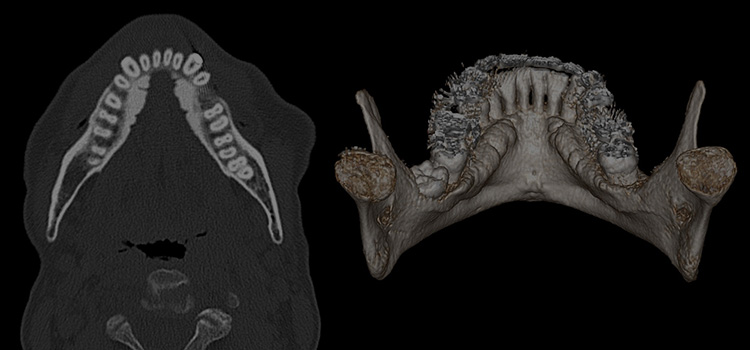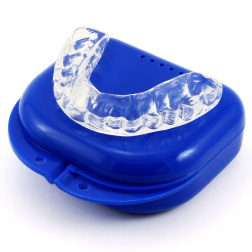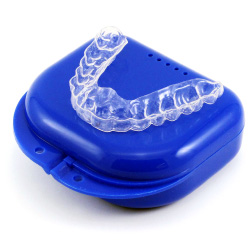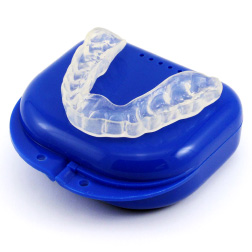Mandibular Tori, Causes and Treatment
8th Feb 2020

They might have caught your attention when the sharp corner of a wayward tortilla chip scraped them. You may have spotted them while flossing. Perhaps your dentist pointed them out to you during a routine checkup. Whatever prompted their discovery, learning that those hard, bony bumps hiding behind your bottom teeth are common enough to have a medical name offers some reassurance. Clearly, you aren't the only one dealing with them. However, it still leaves plenty of questions. What are mandibular tori (or in other words torus mandibularis)? What do they mean for your oral health?

Understanding Mandibular Tori
When you're trying to understand what mandibular tori are, it helps if you know the names of a few landmarks in your mouth:
- Mandible: The bone that forms the lower jaw, the mandible is the strongest bone in the face.
- Maxilla: The upper jawbone, the maxilla holds the upper teeth.
- Palate: A mix of hard and soft tissue, the palate is the roof of the mouth. It separates the oral cavity, or mouth, from the nasal cavities.
- Mylohyoid: The mylohyoid muscle forms the floor of the mouth.
- Lingual: Lingual describes something as either relating to or being near the tongue. For example, the lingual side of a tooth is the surface closest to the tongue.
- Buccal: Buccal identifies something as either relating to or being near the cheek. A tooth's buccal surface is the side closest to the cheek.
It's also useful to know a couple relevant medical terms:
- Exostosis: New bone growth on top of existing bone. Called exostoses when there's more than one bony exostosis, they can be found anywhere in the body.
- Torus: A slow-growing bump of excess bone found in the mouth. Referred to as tori when there are multiple growths, they are normally harmless.
What Are Tori?
Why would a discussion of mandibular tori start with a quick anatomy lesson? Mandibular tori aren't the only type of oral tori, and the realm of real estate is far from the only place where location matters. Having a basic map of your mouth makes it easier to understand tori because dentists categorize these benign bony growths by location:
- Mandibular Tori:
Sometimes referred to as torus mandibularis, this type of tori is located on the lingual side of the mandible near the origins of the mylohyoid. That means you'll find these growths tucked behind the bottom teeth under the tongue:
- Maxillary Tori:
Also known as a torus palatinus or torus palatines, this kind of tori is found on the palate, or roof of the mouth.
- Buccal Exostoses:
These tori are found on the gums on the cheek side of the upper molars.
What does the presence of oral tori mean for your dental health? That depends on the tori. In many cases, it's merely a matter of curiosity. In others, it could be a serious concern. What do you need to know about tori?
Tori are common. According to the Cleveland Clinic Journal of Medicine, torus palatinus can be found in 20% of the American population, and 6% have mandibular tori. Torus mandibularis also tend to be bilateral. Roughly 80% of patients with these growths will have them on both the right and left sides of their mouth.
Tori are not cancerous and do not evolve into cancer. They are simply small hills of extra bone. Covered with normal gum tissues, they grow very slowly and rarely cause symptoms. In fact, many people don't realize they're there until a dental professional points them out.

What Causes Tori Growth?
What spurs the growth of tori? Experts point to a variety of factors, but genetics often tops the list of possible causes. These growths are more common in certain ethnicities, and a tendency towards tori seems to run in families. In fact, a study of twin siblings reported by the National Institutes of Health provides a strong argument for a genetic role. Researchers examined identical and fraternal twins, checking to see if tori were either present or absent in both or present in only one of the pair. Among identical twins, only 6% of pairs saw only one twin impacted. For fraternal twins, who have more genetic differences, the percentage of pairs where only one twin had tori more than tripled, rising to 20%.
What other things might contribute to tori growth? Trauma to the jaw is a possible culprit. Dietary factors like fish consumption, a calcium-rich diet, certain vitamin deficiencies, and the habitual chewing of meats that are dried or frozen may also increase the risk of tori development.
Dental issues may also trigger tori growth. While it's just a theory, some experts suspect that these growths are a kind of natural defense intended to provide extra support and stability to teeth that are under strain. Therefore, conditions that stress the teeth like a misaligned bite or bruxism, which involves habitual grinding of the teeth and clenching of the jaw, may spur the growth of tori.
Issues Related to Tori
If mandibular tori are benign and asymptomatic, how could they cause troubles for your dental health? The soft tissue covering tori is fragile, so scrapes and bumps can cause pain and open the door to infection. Large mandibular tori can make it tough to clean nearby teeth, which might increase your risk of tooth decay. To make matters worse, they may interfere with your dentist's efforts to take X-rays, which can make it tougher to identify dental issues while they are smaller and easier to treat. In addition, these growths can make it impossible to wear dentures or other fitted oral appliances. In fact, if mandibular tori get large enough, they can interfere with the tongue's movements, impacting speech and making eating a challenge.
Fortunately, torus mandibularis and other types of tori grow very slowly. Patients generally have time to explore the available treatment options and decide which one best suits their unique circumstances.

Treating Mandibular Tori (Torus Mandibularis)
What kind of treatment will a dentist recommend for a patient with mandibular tori? That depends. Tori are normally easy to identify, but in cases where the diagnosis is iffy, a dentist may recommend a biopsy. This quick testing can eliminate worries about more dangerous oral growths and provide peace of mind.
If mandibular tori are small, painless and not causing problems, dentists often recommend a wait-and-see approach. After all, many people with mandibular tori never have any trouble. Plus, the slow pace of growth means that there's plenty of time to spot a problem and take action if necessary. What type of action? When mandibular tori cause trouble, surgical removal is generally the proposed solution.
"As dental professionals, we need to be cognizant of our patient’s anatomy… and whenever necessary, alert the patient to the potential for successful surgical intervention," writes Debra Viger, BHS, RDH, in Today's RDH. While there are risks with any surgery, the surgical removal of mandibular tori is considered both safe and effective. When are dentists likely to recommend that a patient visit an oral surgeon?
- The tori are painful or unsightly.
- The tori are making eating, drinking, speaking clearly or cleaning the teeth difficult.
- The tori are interfering with the placement of dentures or other needed oral appliances.
Living With Mandibular Tori
If you've been diagnosed with mandibular tori, what steps can you take to protect your oral health? Thankfully, these benign growths generally aren't a problem. Following the standard recommendations about maintaining a good oral hygiene routine and getting regular dental checkups should be all that's needed. If you have any concerns about teeth grinding, don't wait. Because stressing the jaw could be a factor in mandibular tori growth, you'll want to be proactive about dealing with bruxism. Fortunately, if you learn that teeth grinding or jaw clenching is a problem, a night guard offers a simple solution.
Related Articles:
Please note: if you have mandibular tori, we DO NOT recommend purchasing a night guard online. The impression process required may be complicated by the tori and it may lead to pain or injury. Please consult your dentist directly to get a custom fitted night guard.
Pro Teeth Guard makes getting a custom-fitted night guard easy and affordable. Our oral appliances are made in professional dental labs using high-quality materials, so you get an excellent product at a much lower price than you'd pay at the dentist's office. Contact us today to learn more.
Sources:
- National Institutes of Health - https://www.ncbi.nlm.nih.gov/pubmed/26879267
- Today's RDH - https://www.todaysrdh.com/
- Photo By Hellerhoff - Own work, CC BY-SA 3.0,
https://commons.wikimedia.org/w/index.php?curid=42...

- Most Popular
- Hard Outside, Soft Inside
- 2MM Thick
- Moderate / Heavy

- Most Durable
- Hard Materials
- 1.5MM Thick
- Heavy / Severe

- For Day Time Use
- Thin, Barely Visible
- 1MM Thick
- Light / Moderate

- For Clenching
- Flexible & Soft
- 1.5MM Thick
- Light / Moderate

